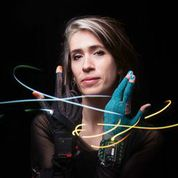Wearable tech gloves that will change the way we make music

You often see musicians moving between different controllers or instruments when playing. But clicking a mouse or moving a fader doesn't always get them really close to the sounds they're trying to create.

Imogen Heap intends to change this. She has created a glove that turns movement into sound. Heap is a British eclectic, eccentric, and innovative recording artist whose last album, Ellipse, earned her a Grammy and Ivor Novello award.
She got the idea for bringing the Mi.Mu glove to life after visiting the MIT Media Lab in 2010, where she saw a prototype of a device that allowed the user to "capture" sound using hand motions.
Heap realized the impact this could have on music and art.
Although turning movement into sound allows an electronic music show to be more visually engaging, the glove is not only intended for performing musicians.
A child can learn an instrument in a unique and exciting way. A deaf person can use gestures to emit audible words and converse with others who don't know sign language.
This glove helps you control the equipment more naturally and it seems intuitive. The idea is to use the computer as expressively as playing the piano so that the movements that are made reflect the sound that you hear.
The glove accesses music software and can be mapped to sounds, and sensors monitor movement and bend of the hands. See how Heap uses the gloves in this video.
The software and hardware will be open source to see how people can find other potential uses for them.
Since that visit to MIT, Heap has done four years of research, development, and iteration. She now has joined the “nerd underworld,” bringing together a team of eight, engineers, designers, and artists.
Over time, the gloves have become more mobile. The original versions required a user to be plugged into multiple computers at the same time.
The cost has become more affordable too. Now the latest wireless glove sells for 1,200 UK pounds ($2,000).
AR + VR
The gloves record each movement of every finger and can be programmed to make sounds accordingly, allowing you to compose music with computers in a "new and intuitive way."
According to the team, the Mi.Mu gloves can "feel" every digit on your hand, such as a peace sign or a thumbs-up. There is an almost limitless variety of gestures that a user can make to emit unique sounds.
No two people will ever "play" the gloves the same — the software is open source and wholly customizable. The gloves also come equipped with a sensor, called the X-OSC module, that is fully aware of your hand’s rotation, speed of movement, and spatial position.
It's similar to how a smartphone has an internal compass and accelerometer — but on every finger, and with greater precision. The gloves are fitted with lights and vibration motors to provide the wearer with feedback.
Software is being developed to connect the gloves to your own system so that you can design gestures that are unique to your particular creative application. They listen out for midi and open sound control.
"Sometimes touching a fader, pressing a button or hunching over a laptop just feels flat. It’s always frustrated me that the bits involving computers and technology never correlated to the sounds and effects being created" ~ Imogen Heap
The team is looking to fund the next level of development for dozens of gloves through their Kickstarter campaign. They're spreading the word, finding early backers, to satisfy a demand to turn motion into sound. The campaign has so far raised £67k+ from over 400 backers.
While the glove today is being applied to music and arts, there are many potential applications.
Deaf people, using sign language, can produce audible hand motions. Doctors' hands can be assisted by audio cues based on movements.
Virtual reality experiences can be fully immersive with tactile capabilities.
Kickstarter collaborators will get a pair of prototype gloves and can work with the team. Feedback from this phase will go into the final design when the gloves go into production.
A larger group of "glovers" will be the first to get their hands into the production gloves.
Heap reckons that these gloves will "revolutionise the way in which music can be composed and performed." With this kind of wearable tech, the future in gesture-based wearables is only just beginning.
I really hope the team reaches its goal.
Related articles: